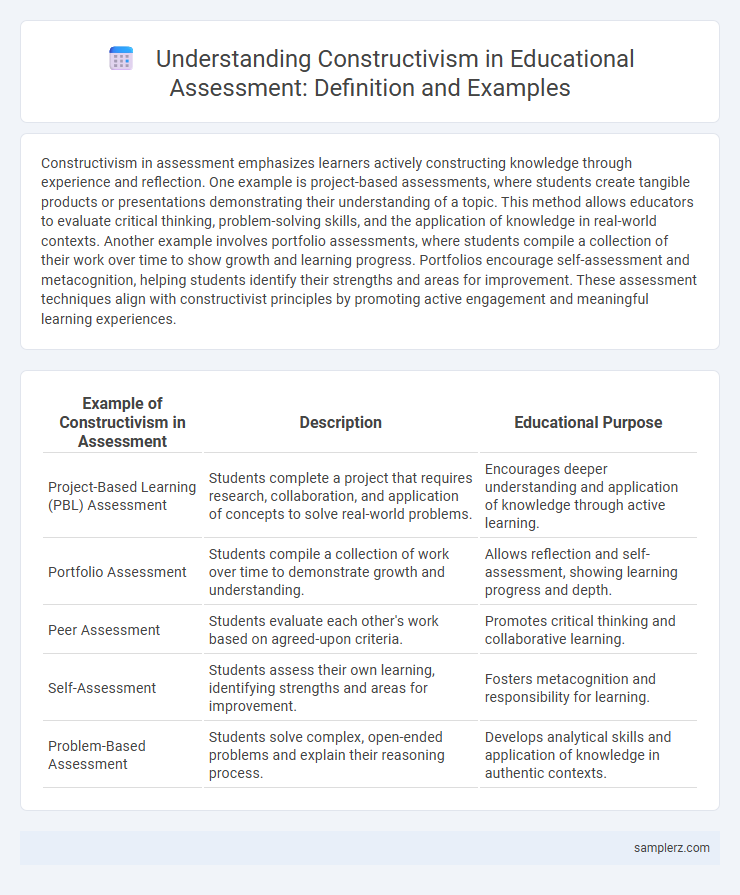Constructivism in assessment emphasizes learners actively constructing knowledge through experience and reflection. One example is project-based assessments, where students create tangible products or presentations demonstrating their understanding of a topic. This method allows educators to evaluate critical thinking, problem-solving skills, and the application of knowledge in real-world contexts. Another example involves portfolio assessments, where students compile a collection of their work over time to show growth and learning progress. Portfolios encourage self-assessment and metacognition, helping students identify their strengths and areas for improvement. These assessment techniques align with constructivist principles by promoting active engagement and meaningful learning experiences.
Table of Comparison
| Example of Constructivism in Assessment | Description | Educational Purpose |
|---|---|---|
| Project-Based Learning (PBL) Assessment | Students complete a project that requires research, collaboration, and application of concepts to solve real-world problems. | Encourages deeper understanding and application of knowledge through active learning. |
| Portfolio Assessment | Students compile a collection of work over time to demonstrate growth and understanding. | Allows reflection and self-assessment, showing learning progress and depth. |
| Peer Assessment | Students evaluate each other's work based on agreed-upon criteria. | Promotes critical thinking and collaborative learning. |
| Self-Assessment | Students assess their own learning, identifying strengths and areas for improvement. | Fosters metacognition and responsibility for learning. |
| Problem-Based Assessment | Students solve complex, open-ended problems and explain their reasoning process. | Develops analytical skills and application of knowledge in authentic contexts. |
Integrating Constructivism into Assessment Practices
Integrating constructivism into assessment practices involves designing tasks that encourage students to actively construct knowledge through problem-solving and critical thinking, such as project-based assessments and reflective journals. These methods emphasize authentic learning experiences, allowing learners to demonstrate understanding in real-world contexts and promote deeper cognitive engagement. Formative assessments guided by student-centered feedback loops further support self-regulation and metacognitive skills development aligned with constructivist principles.
Authentic Assessment: Constructivist Approaches
Authentic assessment exemplifies constructivist approaches by engaging students in real-world tasks that require critical thinking and problem-solving, allowing learners to demonstrate understanding through practical application. This method emphasizes active participation, reflection, and the integration of prior knowledge, fostering deeper learning connections. Portfolio assessments, project-based tasks, and performance-based evaluations are common authentic assessment tools aligned with constructivist principles.
Project-Based Assessments: Real-World Learning
Project-based assessments allow students to engage in real-world learning by creating tangible projects that demonstrate their understanding of concepts through application. These assessments promote critical thinking, collaboration, and problem-solving skills by requiring learners to explore authentic challenges and produce meaningful results. Educators can evaluate knowledge retention and practical skills by analyzing project outcomes and reflective processes within constructivist frameworks.
Collaborative Evaluation in Constructivist Classrooms
Collaborative evaluation in constructivist classrooms fosters student engagement by encouraging peer feedback and group problem-solving, enhancing deeper understanding of the subject matter. This approach aligns with constructivist principles by allowing learners to co-construct knowledge through meaningful interactions and reflective discussions. Research shows that students involved in collaborative assessments demonstrate improved critical thinking skills and greater retention of learned concepts.
Reflective Journals as Constructivist Assessment Tools
Reflective journals serve as effective constructivist assessment tools by encouraging students to critically analyze their learning experiences and connect new knowledge with prior understanding. These journals promote metacognition, allowing learners to articulate their thought processes and identify areas for improvement. Through reflective journaling, educators gain insights into students' personal learning journeys, fostering a deeper, learner-centered assessment approach.
Formative Assessment Aligned with Constructivist Principles
Formative assessment in constructivist education involves continuous feedback that helps learners actively construct knowledge through self-reflection and peer collaboration. Techniques such as reflective journals, concept maps, and student-led discussions encourage critical thinking and personal meaning-making aligned with constructivist principles. Teachers guide learners to identify gaps in understanding, fostering deeper comprehension and lifelong learning skills.
Peer Assessment and Constructive Feedback
Peer assessment in constructivist education actively engages students in evaluating each other's work, fostering critical thinking and deeper understanding. Constructive feedback within this process helps learners identify strengths and areas for improvement, promoting self-regulation and collaborative learning. This approach enhances metacognitive skills and supports the development of a growth mindset by encouraging reflection and dialogue.
Performance Tasks: Measuring Deep Understanding
Performance tasks in education serve as effective examples of constructivism in assessment by requiring students to apply knowledge and skills in real-world contexts, thereby measuring deep understanding beyond rote memorization. These tasks involve complex problem-solving, critical thinking, and the integration of multiple concepts, enabling educators to evaluate students' ability to transfer learning to new situations. By emphasizing authentic challenges and reflective processes, performance tasks align with constructivist principles that prioritize active, meaningful learning experiences.
Portfolios: Documenting Student Learning Progress
Portfolios in assessment provide a dynamic, student-centered approach aligned with constructivist principles by allowing learners to actively compile and reflect on their work over time. This method captures diverse evidence of understanding and skill development, offering a holistic view of student progress beyond traditional tests. Educators use portfolios to facilitate personalized feedback and support metacognitive skills essential for deeper learning and self-assessment.
Self-Assessment: Empowering Learners Through Reflection
Self-assessment in education allows learners to critically evaluate their own understanding and progress, fostering deeper engagement and ownership of learning outcomes. Reflective practices enable students to identify strengths, pinpoint areas for improvement, and set personalized goals aligned with constructivist principles. This learner-centered approach enhances metacognitive skills and supports continuous, meaningful knowledge construction.

example of constructivism in assessment Infographic
 samplerz.com
samplerz.com